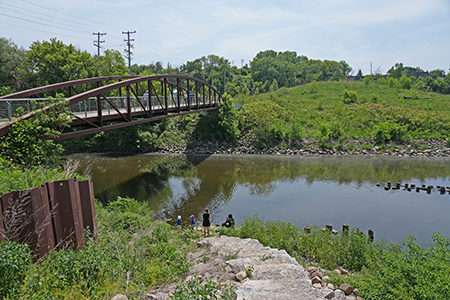 Whether it is the paved trails that wind around sculpted rolling hills or the small oaks that are growing into mighty giants or the stunning views of Milwaukee’s skyline, beauty awaits you at every corner of Three Bridges Park, a 24-acre urban oasis in the Menomonee Valley.
Whether it is the paved trails that wind around sculpted rolling hills or the small oaks that are growing into mighty giants or the stunning views of Milwaukee’s skyline, beauty awaits you at every corner of Three Bridges Park, a 24-acre urban oasis in the Menomonee Valley.
Just as beautiful as the park itself are the partnerships it took to transform piles of dirt and rubble into one of Milwaukee’s newest destinations.
“It shows that if you get the right stakeholders at the table, you can literally move hills,” said Dave Misky, Redevelopment Authority of the City of Milwaukee’s assistant executive director. “We did.”
On paper, nine entities made up the partnership that created the park, a project more than a decade in the making that opened in 2013. In reality, more than 400 people were involved in the evolution of the brownfield-turned green space, with contributions ranging from planning to planting to pledging money.
The park sprang forth from a national design competition in 2002 spearheaded by the city, Sixteenth Street Community Health Center and Menomonee Valley Partners. The Urban Ecology Center, departments of Transportation and Natural Resources and others later came on board to bring it to life.
The project’s scope, scale and magnitude pushed each partner beyond their comfort levels, said Corey Zetts, MVP’s executive director. MVP never managed a major capital campaign. The city was not in the park business. DOT managed construction of roads, not green spaces. However, each brought different strengths and backgrounds that contributed to the project’s success, Misky said.
“If we were missing any one piece, the project would have suffered because each voice was so valuable,” Zetts said.
Zetts said that despite the park’s long gestational period, which included a recession midway through, it was not hard to keep the momentum going because of the community’s engagement and excitement.
“What helped the process along for everyone was just seeing the community’s excitement around the project,” she said. “That was always really a motivator for everyone to get all the nitty gritty pieces done.”
The work did not end once the park opened. Each partner agreed to certain responsibilities to maintain the park and all remain committed to ensuring it will exist in perpetuity. An endowment was seen as a critical piece needed to fulfill that goal and all signs pointed to the Foundation for multiple reasons, Zetts said.
“Not only do its investments perform really well, but it just felt like the right place for trying to create something that is leaving a lasting legacy to the community,” she said.
Zetts still gets goosebumps, especially when she hears about or sees others benefit from the park.
“In 20 years, some kid is going to say ‘No way was this a rail yard! This has always been a park,’” she said. “I hear a lot of people who feel like seeing that transformation makes them really hopeful. If Milwaukee can do this, then really what can’t we do?”